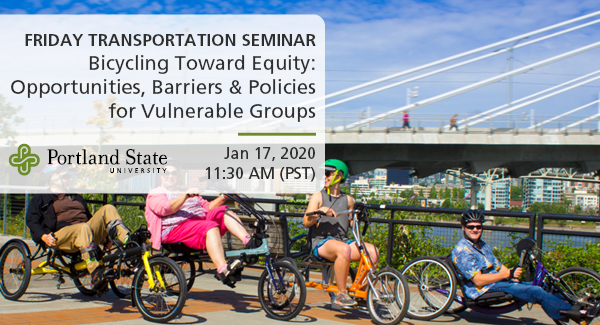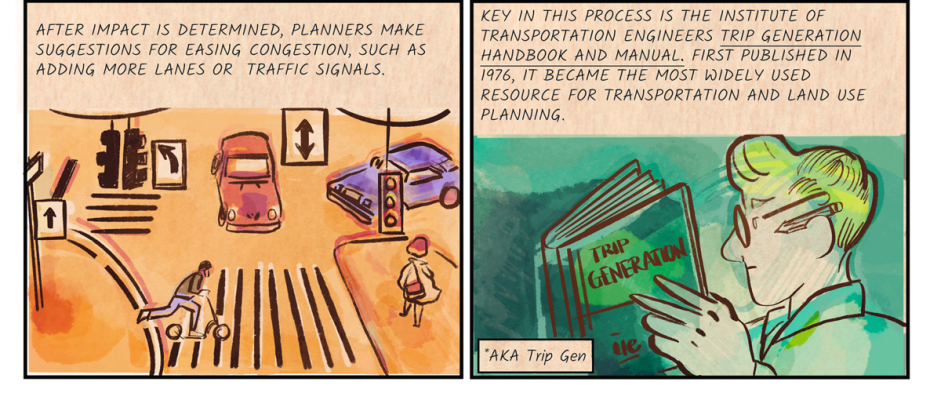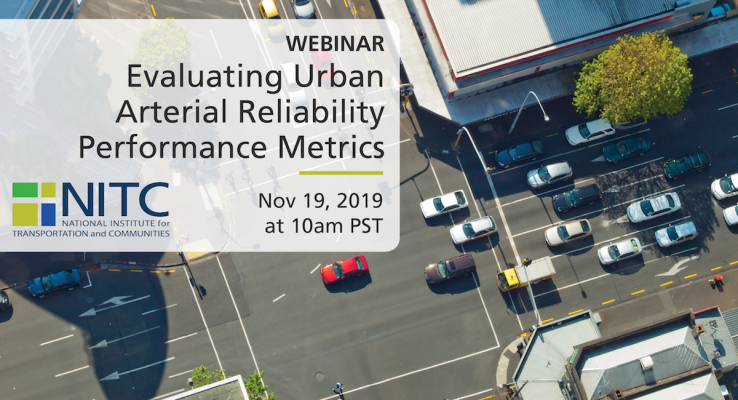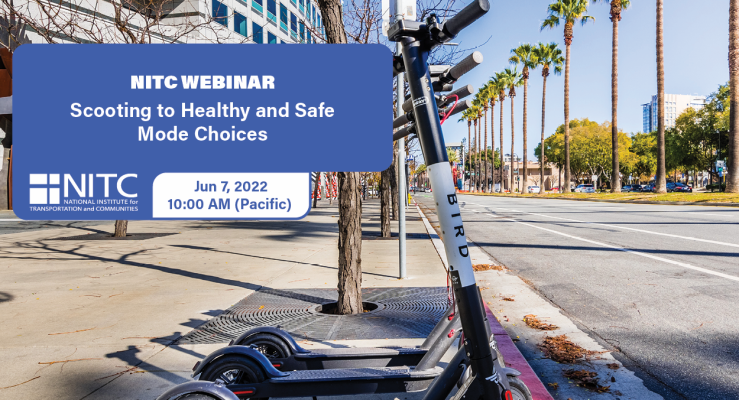The video begins at 3:49.
Friday Transportation Seminars at Portland State University have been a tradition since 2000. You can join us in person at 11:30 AM, or you can also watch online.
PRESENTATION ARCHIVE
- View Jennifer Dill's presentation slides (Women of Color on Two Wheels)
- View John MacArthur's presentation slides (Adaptive Bikeshare)
- Watch the video
THE TOPIC
This seminar will include two papers that will be presented earlier in the week at the Annual Meeting of the Transportation Research Board in Washington, DC.
Adaptive Bikeshare: Expanding Bikeshare to People with Disabilities and Older Adults
Bike share systems are expanding efforts to be more equitable and accessible...
Read moreGot research? Like comics? Learn how to bring the two together in this hands-on workshop.
Open to students and faculty at Portland State University, this workshop will provide an introduction to comics as a means to communicate research. Come prepared to learn about the power of comics as a communication and learning tool, some recent examples of research comics from PSU, and the comic studies program.
No previous experience in comics is necessary. Space is limited so register now!
This event is sponsored by the National Institute for Transportation and Communities (NITC), Research and Graduate Studies, and Comics Studies at PSU.
Learn more about the NITC project Communicating Research through Comics: Transportation and Land Development.
Portland State University's Transportation Research and Education Center (TREC) is home to the U.S. DOT funded National Institute for Transportation and Communities (NITC), the Initiative for Bicycle and Pedestrian Innovation (IBPI), PORTAL, BikePed Portal and other transportation grants and programs. We produce impactful research and tools for transportation decision makers, expand the diversity and capacity of the workforce, and engage students and professionals through education and participation in research.
Join us for a three day introductory in-person workshop on databases and SQL
Each day will be a combination of a lecture and practical. We will cover:
- Introduction to relational databases.
- Structured query language (SQL).
- How to setup a PostgreSQL database on your local machine and use it to analyze data.
Software Requirements
You will be expected to bring your own laptop and have all required software installed prior to the workshop. If you are using a work-issued laptop, you will most likely need administrator privileges to install the following required software:
- PostgreSQL – Download at: https://www.postgresql.org/download/
- pgAdmin4 – Download at: https://www.pgadmin.org/download/
REGISTRATION
PROFESSIONAL DEVELOPMENT
This three-day workshop is eligible for 9 hours of professional...
Read moreThe video begins at 0:48.
View slides
Speaker: Darwin Moosavi, MURP, Portland State University
Topic: Capturing the Ride: Exploring Low-Density Flexible Transit Alternatives in Salem-Keizer
Summary: Current fixed-route transit service provided by Salem-Keizer Transit is inefficient in the low-density neighborhoods of West Salem, South Salem, and Keizer. The lack of sidewalks, non-gridded circuitous streets, and large single-family residential lots all contribute to a lack of ridership. As a result, traditional fixed-route transit service is not cost-effective in these areas. Through a five month planning process, a group of Portland State University graduate students, better known as Paradigm Planning, tackled the task of addressing this problem in each of the three study areas. Paradigm’s planning process explored mode and route options in order to produce a plan that provides innovative and feasible alternatives to current transit service that will better meet the needs of the community. Through an intensive community engagement process, the residents in each neighborhood were given a voice in shaping the future of transit in their neighborhood.
Bio: Darwin Moosavi is a Master in Urban & Regional Planning candidate at Portland State University and Project...
Read moreSteve Szigethy and Jamison Kelleher, a team of graduate students in PSU's Master of Urban and Regional Planning program, will present their Planning Workshop project entitled "Imagine 82nd." The project engaged residents, businesses, property owners and students along NE 82nd Avenue in Portland to develop a comprehensive vision for the future of the corridor. Imagine 82nd deals with the portion of 82nd Avenue between the Banfield Expressway and NE Sandy Boulevard, 1.3 miles in length. This particular stretch is home to many retail and service businesses that typify the rest of 82nd Avenue, but it also includes Madison High School, a major corporate headquarters, and a 20-acre vacant brownfield site. At this seminar, Steve Szigethy and Jamison Kelleher will present the vision concepts they developed with the community, with particular emphasis on transportation and land use components.
The video begins at 5:54.
PRESENTATION ARCHIVE
Miss the webinar or want a look back?
OVERVIEW
With worsening congestion, travel time reliability is increasingly becoming as critical as average travel times in affecting travel choices. Researchers from Portland State University (PSU) partnered with Washington County, Oregon to offer data-driven strategies in prioritizing funding for travel time reliability improvements on their urban arterials. The vast majority of existing research on travel time reliability has focused exclusively on freeways. Avinash Unnikrishnan, Sirisha Kothuri and Jason C. Anderson leveraged Bluetooth sensors provided and deployed by Bluemac Analytics to identify problem areas in the county. Set up at intersections throughout Washington County, the sensors are able to calculate travel time from one intersection to another by matching Bluetooth signals from devices in people's cars. The researchers evaluated the Bluetooth travel time data to understand the temporal variation in travel time reliability metrics on these urban arterials, including factors related to time of day, weather, and holidays....
Read morePRESENTATION ARCHIVE
OVERVIEW
Shared electric scooters (e-scooters) are fast becoming a mobility option in cities across the United States. This new micromobility mode has the potential to replace car usage for certain trips, which stands to have a positive impact on public health and sustainability goals. However, many aspects of this emerging mode are not well understood.This webinar explores the findings of three NITC studies examining transportation mode choices, safety, and public health outcomes of electric scooters.
KEY LEARNING OUTCOMES
By the end of this presentation, the participant will be able to:
- describe the ways in which electric scooters may provide new substitutive, complimentary or synergist transportation opportunities for different activities...





